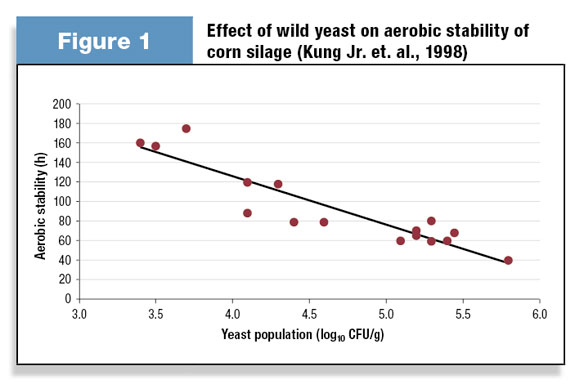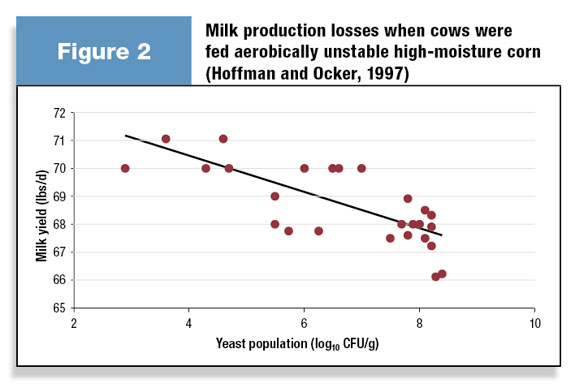It is every dairyman’s desire to feed high-quality corn silage and/or haylage to ensure excellent animal health and production and keep feed costs in line. However, maintaining the silage in good condition throughout the feeding period is a challenge.
Silage fermentation involves the action of lactic acid bacteria on crops with high moisture content under anaerobic conditions.
However, as silage is exposed to air during storage or at feeding time, aerobic spoilage occurs promptly due to lactic acid degradation by the mainly lactic acid-utilizing yeasts (i.e., Pichia and Candida). This consequently leads to an increase in pH and high losses of nutrient and dry matter in silage.
Research tells us that high yeast counts are indicative of feeds likely to be unstable in an aerobic environment. In other words, these feeds will get warm and go out of condition when exposed to air and spoil quickly, especially in hot weather.
Will this year’s corn silage be more or less likely to have wild yeast problems? Why? See the answer below.
Why is high level of wild yeast a problem?

Wild yeast that grows in silage and fermented feeds with poor face management consumes the energy in the feed, making less available for milk production.
Wild yeast also creates aerobic instability ( Figure 1 ) in the wet feeds, causing the feed to heat, leading to off-feed problems in dairy cattle.
Field nutritionists report seeing loose manure, decreased milk fat test, lowered intakes and decreased milk production ( Figure 2 below ) when they encounter high levels of yeast in corn silage and/or high-moisture corn.
Infrared technology shows a tremendous amount of heating in corn silage exposed to air because of poor face management.

What are the sources of wild yeast?
- Corn silage
- High-moisture corn
- Wet distillers grains
- Wet corn gluten feed
- Wet brewers grains
What strategies should you use when dealing with high-yeast feed ingredients?
Aerobic instability of fermented or wet feeds caused by wild yeast, particularly during warm feeding season, could result in reduced feed intake and production of milk and milk components.
The negative effect of wild yeast could be mediated via reduced nutrient availability of affected feeds and sub-optimal rumen microbial fermentation. Practical strategies to minimize the effect of high-yeast feeds include:
- Proper silage bunker face management
- Discontinue feeding aerobically unstable feed during warm weather
- Remove 12 to 18 inches per day or more in warm weather months
- Feed from “smaller feedout faces” in warm weather months
- Minimize the time between wet feeds removal and feeding PD
References omitted due to space but are available upon request to editor@progressivedairy.com .
—Excerpts from Diamond V’s Nutrition Line.

-
Ilkyu Yoon
- Senior Research Manager
- Diamond V Mills
- Email Ilkyu Yoon
Will this year’s corn silage be more or less likely to have wild yeast problems? Why?
We are expecting fewer issues with wild yeast in the 2010 corn silage crop compared to last year, due to the ideal fall harvest we had, at least in the Upper Midwest. I cannot speak for other areas of the U.S. The other reason that I say we expect fewer issues is because to this point we have not heard of as many issues.
However, the spring is usually when we discover issues with wild yeast in corn silage as the weather warms up. So, it’s hard to predict what we might get in 2011.
Tom Oelberg is a technical field specialist withDiamond V Mills. Email Tom Oelberg.






